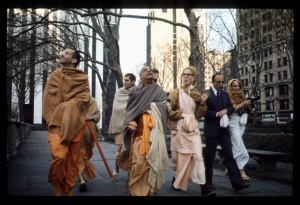When Kṛṣṇa and His devotees meet, it is technically called yoga, or linking up with the Lord. Such meetings between Kṛṣṇa and His devotees can be divided into three classes—namely, perfection, satisfaction, and steadiness. When the devotee meets with Kṛṣṇa in great eagerness, that state of meeting is called perfection.
In the Kṛṣṇa-karṇāmṛta, Bilvamaṅgala Thākur describes how Kṛṣṇa meets His devotee—with peacock feather on His head, with marakata jewels on His chest, with His ever-enchanting smile, His restless eyes and His very delicate body.
In the Tenth Canto of Śrīmad-Bhāgavatam, 38th Chapter, 31st verse, Śukadeva Gosvāmī tells King Parīkṣit: "My dear King, as soon as Akrūra the chariot driver saw Lord Kṛṣṇa and His elder brother Balarāma in Vṛndāvana, he immediately got down from the chariot and, being greatly afflicted by affection for the transcendental Lord, fell down upon His lotus feet to offer respectful obeisances." These are some of the instances of perfectional meetings with Kṛṣṇa.
When a devotee meets Kṛṣṇa after long separation, it is called satisfaction. In the First Canto of Śrīmad-Bhāgavatam, 11th Chapter, 9th verse, it is stated that when Lord Kṛṣṇa returned to His capital, Dvārakā, the inhabitants began to say, "My dear Lord, if You remain in foreign countries for so long, we shall certainly be bereft of seeing Your smiling face! And observing Your face, we, Your eternal servitors, become greatly satisfied. All the anxieties of our existence are immediately mitigated. If we cannot see You because You are long absent from Dvārakā, then it will be impossible for us to live anymore." This is an instance of satisfaction in meeting Kṛṣṇa after long separation.
Kṛṣṇa's personal servant, Dāruka, seeing Kṛṣṇa at the door of Dvārakā, forgot to offer Him respects with folded hands.
When a devotee is ultimately situated in association with Kṛṣṇa, his position is called steadiness in devotional service. This steady position in devotional service is explained in the book known as Haṁsadūta. It is described there how Akrūra, who was considered by the gopīs to be terror personified, would talk with Kṛṣṇa about the activities of the Kuru dynasty. A similar steady position was held by Uddhava, the disciple of Bṛhaspati. He would always massage the lotus feet of Kṛṣṇa while kneeling down on the ground before Him.
When a devotee is engaged in the service of the Lord, it is called the attainment of yoga. The English equivalent to the word "yoga" is "linking up." So actual linking up with Kṛṣṇa, the Supreme Personality of Godhead, begins when the devotee renders service unto Him. Devotees situated in the transcendental rasa of servitorship render their particular service whenever there is an opportunity. Sometimes they sit down in front of Kṛṣṇa to receive orders. Some persons are reluctant to accept this level of devotional service as actual bhakti-yoga, and in some of the Purāṇas also this servitorship in devotional service to Kṛṣṇa is not accepted as the actual bhakti-yoga system. But in the Śrīmad-Bhāgavatam it has been clearly indicated that the servitor relationship with Kṛṣṇa is the actual beginning of yoga realization.
In the Eleventh Canto of Śrīmad-Bhāgavatam, 3rd Chapter, 33rd verse, it is stated that when devotees are engaged in the discharge of bhakti-yoga, sometimes they cry from thinking of Kṛṣṇa, sometimes they laugh, sometimes they become jubilant, and sometimes they talk in very uncommon ways. Sometimes they dance, sometimes they sing, sometimes they are actually engaged in the service of the Lord, and sometimes they sit down silently as if absorbed in trance.
Similarly, in the Seventh Canto of Śrīmad-Bhāgavatam, Chapter 28, Prahlāda Mahārāj says to his friends: "My dear friends, as soon as pure devotees of Lord Kṛṣṇa hear of the transcendental pastimes of the Lord, who is the eternal reservoir of pastimes, or hear about His transcendental qualities they become overpowered with jubilation. Ecstatic symptoms are manifested in their bodies. They shed tears, talk falteringly, glorify the Lord in a loud voice and chant and dance in ecstasy. These ecstasies are always there, but sometimes they overcome all limits, and the symptoms become manifest to all."
In the process of surrender unto the Supreme Personality of Godhead there are six items: to accept everything which is favorable for devotional service, to reject everything which is unfavorable for devotional service, to believe that Kṛṣṇa will always give protection, to identify oneself with Kṛṣṇa's devotees, to always feel inability without the help of Kṛṣṇa, and to always think oneself inferior to Kṛṣṇa, even though one may have full capacity to perform something on his own. When one is substantially convinced that he is always protected by Kṛṣṇa in all circumstances, that feeling is called reverential devotion. Reverential devotion is executed in relation with the Supreme Personality of Godhead and with His other protected devotees.
When Kṛṣṇa was residing in Dvārakā, some of the elderly members of the Yadu family would occasionally put some important matter before Him. At such a time, Kṛṣṇa would carefully give attention to those matters. And if there were some humorous topics mentioned, Kṛṣṇa would immediately respond with a smiling face. Sometimes when Kṛṣṇa was executing His duties in the assembly known as Sudharmā, He would ask the elderly members for good advice. By such activities He is manifest as the supreme spiritual master, the supreme executive head, the superior intelligence, the supreme power, protector and maintainer.
